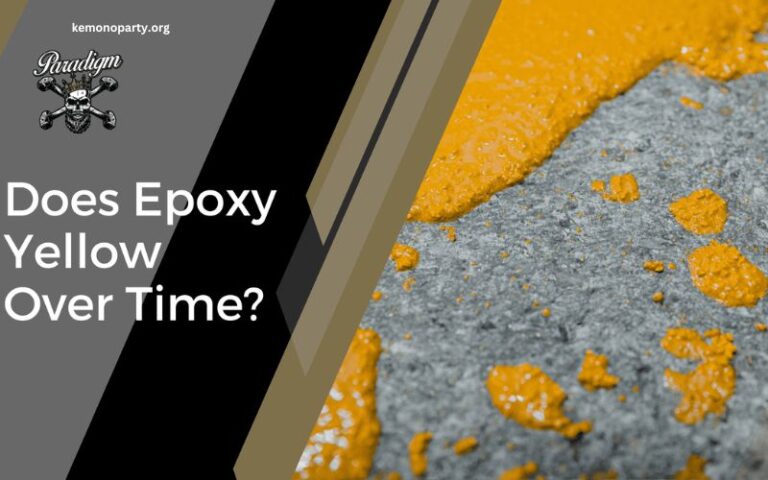Table of Contents
ToggleUnderstanding Epoxy Resin
Epoxy resin is a type of thermosetting polymer that is created by mixing two components: resin and hardener. When these components are combined, they undergo a chemical reaction that causes the mixture to cure and solidify. Epoxy resins are used in a variety of applications, including coatings, adhesives, and casting.
One of the key attributes of epoxy resin is its ability to maintain a clear, glass-like finish when properly mixed and cured. This clarity makes it an ideal choice for applications where aesthetics are important, such as in jewelry making, art projects, and protective coatings. However, over time, some epoxy resins may exhibit changes in appearance, including yellowing.
Factors Contributing to Epoxy Yellowing
Several factors can contribute to the yellowing of epoxy resin over time. Understanding these factors can help in choosing the right epoxy resin for your project and taking steps to prevent or minimize yellowing.
1. UV Exposure
Ultraviolet (UV) light is one of the primary causes of yellowing in epoxy resin. UV rays from the sun can break down the chemical bonds in the resin, leading to a discoloration of the surface. This is particularly evident in outdoor applications or in projects that are exposed to direct sunlight for extended periods. Epoxy resins that do not contain UV stabilizers or inhibitors are more susceptible to yellowing.
2. Heat
Heat can also contribute to the yellowing of epoxy resin. High temperatures can accelerate the degradation of the resin and lead to changes in color. This is especially true if the epoxy is exposed to elevated temperatures for prolonged periods. Proper curing conditions and avoiding excessive heat can help in reducing the risk of yellowing.
3. Chemical Reactions
Certain chemical reactions can cause epoxy resin to yellow. For example, the reaction between epoxy resin and certain substances, such as amines or other reactive chemicals, can lead to discoloration. It is important to use compatible materials and follow the manufacturer’s guidelines to minimize the risk of unwanted reactions.
4. Quality of the Epoxy Resin
The quality of the epoxy resin itself plays a significant role in its susceptibility to yellowing. Higher-quality epoxy resins are often formulated with UV stabilizers and other additives that help prevent yellowing. Cheaper or lower-quality resins may not have these additives and are therefore more prone to discoloration over time.
Vograce Epoxy Resin and Yellowing
Vograce is a well-known brand in the epoxy resin market, offering a range of products for different applications. One of the key considerations for users of Vograce epoxy resin is whether the resin is prone to yellowing over time. To address this question, we need to look at the specific characteristics of Vograce epoxy resin and how it performs in terms of yellowing.
1. Formulation and Additives
Vograce epoxy resin is formulated with a focus on clarity and durability. The company incorporates UV stabilizers and other additives in its resin formulations to help prevent yellowing. These additives work by absorbing or blocking UV rays that can cause the resin to discolor. As a result, Vograce epoxy resin is generally less prone to yellowing compared to some other resins on the market.
2. Application Conditions
The conditions under which Vograce epoxy resin is applied and cured also play a role in its resistance to yellowing. Following the manufacturer’s guidelines for mixing, applying, and curing the resin is crucial for achieving the best results. Additionally, using the resin in applications where it is not exposed to direct sunlight or high temperatures can help maintain its clarity.
3. User Reviews and Experiences
Many users of Vograce epoxy resin have reported positive experiences with the product’s clarity and resistance to yellowing. Reviews often highlight the resin’s durability and ability to maintain a clear finish over time. However, it is important to note that individual experiences may vary based on factors such as application techniques and environmental conditions.
Tips for Preventing Epoxy Yellowing
To ensure that your epoxy resin projects maintain their clarity and appearance over time, consider the following tips:
1. Use UV-Resistant Epoxy Resin
If yellowing is a concern, choose epoxy resin products that are specifically formulated to be UV-resistant. These resins contain additives that help protect against UV damage and discoloration.
2. Apply a UV-Resistant Coating
For projects that will be exposed to sunlight, consider applying a UV-resistant coating over the epoxy resin. This additional layer can provide extra protection against UV rays and help prevent yellowing.
3. Store Projects Properly
When not in use, store epoxy resin projects in a cool, dry place away from direct sunlight. Proper storage can help reduce the risk of yellowing and maintain the clarity of the resin.
4. Follow Manufacturer’s Guidelines
Always follow the manufacturer’s guidelines for mixing, applying, and curing epoxy resin. Adhering to these instructions ensures that the resin performs as expected and minimizes the risk of yellowing.
5. Regular Maintenance
For projects that are exposed to environmental factors, such as outdoor sculptures or furniture, regular maintenance can help keep the epoxy resin looking its best. This may include cleaning the surface and applying additional protective coatings as needed.
Conclusion
In summary, Vograce epoxy resin is designed to offer durability and clarity, with features that help resist yellowing over time. While factors such as UV exposure, heat, and the quality of the resin can contribute to yellowing, Vograce’s formulation includes additives that help mitigate these issues. By following proper application and maintenance practices, users can further enhance the longevity and appearance of their epoxy resin projects.
Understanding the factors that contribute to yellowing and taking preventive measures can help ensure that your epoxy resin creations remain vibrant and clear for years to come. Whether you’re a hobbyist or a professional, choosing the right epoxy resin and using it correctly will contribute to the success of your projects and their long-term aesthetics.


